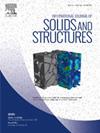Experimental and modeling investigation on anisotropic plastic flow of metal plates under nonproportional loading conditions
IF 3.4
3区 工程技术
Q1 MECHANICS
International Journal of Solids and Structures
Pub Date : 2024-11-30
DOI:10.1016/j.ijsolstr.2024.113174
引用次数: 0
Abstract
The plastic deformation behavior of metal plates has been proved to be affected by loading paths. Plastic flow is a critical component in the mechanical description of plastic deformation, like yield and hardening. In this work, the anisotropic plastic flow of two metal plates (16MnCr5 and S420MC) under non-proportional loading conditions was investigated. Large specimens manufactured along different orientations were pre-tensioned up to various strain levels; subsequently, small uniaxial tensile specimens were cut from the pre-tensioned specimens along different orientations with the interval of 15°, and then loaded to rupture. Meanwhile, the r-value, a measure of anisotropic plastic flow, was recorded. Result shows that for the studied plates which had constant r-value in the monotonic uniaxial tensile tests, a downward evolution of the r-value against plastic strain was observed when the Schmitt angle of two stage loading directions was greater than 90°. As the plastic strain in the subsequent loading stage accumulated, the r-value dropped from a higher level to its original level within a strain range about 6.0%. Based on the transient r-value evolution, a HEXAH-based evolutionary plastic potential model was constructed within the framework of non-associated flow (non-AF) theory. In the model, a local ellipse-shape distortion of the plastic potential surface was defined during plastic deformation process and when the Schmitt angel exceeded 90°, such distortion caused a downward evolution of the r-value in the subsequent deformation. The calibration result indicates that the model could reproduce the transient r-value response relevant to loading path change. The proposed evolutionary plastic potential model can be applied together with different anisotropic hardening models in the non-AF theory to give a detailed description of the plastic deformation behavior and hopefully provide a solution for the accurate simulation of the complex sheet metal forming process.
求助全文
约1分钟内获得全文
求助全文
来源期刊
CiteScore
6.70
自引率
8.30%
发文量
405
审稿时长
70 days
期刊介绍:
The International Journal of Solids and Structures has as its objective the publication and dissemination of original research in Mechanics of Solids and Structures as a field of Applied Science and Engineering. It fosters thus the exchange of ideas among workers in different parts of the world and also among workers who emphasize different aspects of the foundations and applications of the field.
Standing as it does at the cross-roads of Materials Science, Life Sciences, Mathematics, Physics and Engineering Design, the Mechanics of Solids and Structures is experiencing considerable growth as a result of recent technological advances. The Journal, by providing an international medium of communication, is encouraging this growth and is encompassing all aspects of the field from the more classical problems of structural analysis to mechanics of solids continually interacting with other media and including fracture, flow, wave propagation, heat transfer, thermal effects in solids, optimum design methods, model analysis, structural topology and numerical techniques. Interest extends to both inorganic and organic solids and structures.

 求助内容:
求助内容: 应助结果提醒方式:
应助结果提醒方式:


